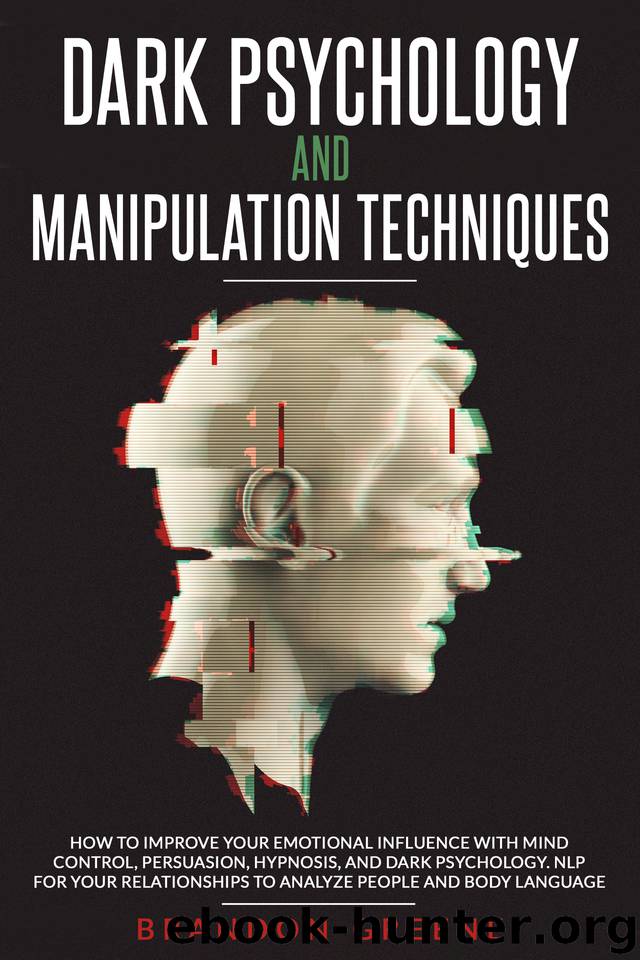Dark Psychology and Manipulation Techniques: How to Improve Your Emotional Influence with Mind Control, Persuasion, Hypnosis, and Dark Psychology. NLP For Your Relationships to Analyze People by Brandon Greene

Author:Brandon Greene [Greene, Brandon]
Language: eng
Format: azw3
Published: 2020-05-09T16:00:00+00:00
Conclusion
T hank you for making it through to the end of Emotional Influence, let’s hope it was informative and able to provide you with all of the tools you need to achieve your goals whatever they may be.
Understanding what emotions are and why we have them are both important to know, but you should also have a good understanding of what emotions mean on an individual level. Here are the seven base emotions upon which all other feelings are built, and what they mean:
Anger
When angry, people drop their eyebrows down with eyelids pulled up and lips tight. This conveys aggression or intimidation — it implies that the person feeling the anger is ready to lash out, either in defense or simply to lash out. This is what people feel when they feel someone is taking advantage of them or that they have been wronged somehow. It conveys a need for boundaries or to protect.
Contempt
When feeling contempt, the expression is almost neutral — one side of the lip is pulled up slightly and briefly, and the brow may occasionally lift as well on the same side as the lip. This conveys that the individual feels disdain or hatred toward whatever has elicited the contemptuous response. It conveys a disgust of sorts in which you wish to avoid the other party.
Disgust
When disgusted, eyebrows turn downward. The nose wrinkles and eyes squint. The mouth opens slightly, with the upper lip being raised. This conveys that something around the individual is toxic or diseased in some way and should be avoided. It conveys a need to avoid whatever it was that offended them.
Fear/Anxiety
When afraid, people lift their eyebrows up and widen eyes. The mouth is usually open slightly. This prepares the individual for fight-or-flight — their widened eyes allow for more light to be taken in, and the opened mouth allows for more oxygen to be breathed. This conveys that there is some sort of danger or threat to the individual and conveys a need for safety or protection.
Joy
When happy, someone usually smiles. The muscles surrounding the individual’s eyes tighten, causing wrinkles. When you feel joy, you are conveying that you are satisfied and have no further needs to be met, and that whatever is happening in that moment is good.
Sadness
Someone who is sad will raise the inner ends of their eyebrows, with loose eyelids, and lips turned downward. Sadness cues the person to slow down or withdraw, and communicates that there has been some sort of loss. It conveys a need for healing and support.
Surprise
When surprised, you typically pull up the eyebrows and eyelids, and your mouth widens. Typically, the eyes dilate as well. This allows for a wider glance around to take in the surroundings and ensure that everything is okay. This conveys that something new and unexpected has happened and requires attention.
Download
This site does not store any files on its server. We only index and link to content provided by other sites. Please contact the content providers to delete copyright contents if any and email us, we'll remove relevant links or contents immediately.
The Black Swan by Nassim Nicholas Taleb(6761)
Bad Blood by John Carreyrou(6271)
Pioneering Portfolio Management by David F. Swensen(6078)
Millionaire: The Philanderer, Gambler, and Duelist Who Invented Modern Finance by Janet Gleeson(4089)
Skin in the Game by Nassim Nicholas Taleb(3965)
The Money Culture by Michael Lewis(3843)
Bullshit Jobs by David Graeber(3826)
Skin in the Game: Hidden Asymmetries in Daily Life by Nassim Nicholas Taleb(3720)
The Wisdom of Finance by Mihir Desai(3523)
Blockchain Basics by Daniel Drescher(3327)
Liar's Poker by Michael Lewis(3220)
The Intelligent Investor by Benjamin Graham Jason Zweig(2930)
Hands-On Machine Learning for Algorithmic Trading by Stefan Jansen(2925)
Mastering Bitcoin: Programming the Open Blockchain by Andreas M. Antonopoulos(2890)
Fooled by Randomness: The Hidden Role of Chance in Life and in the Markets by Nassim Nicholas Taleb(2860)
Investing For Dummies by Eric Tyson(2789)
The Power of Broke by Daymond John(2769)
Market Wizards by Jack D. Schwager(2538)
Zero Hour by Harry S. Dent Jr. & Andrew Pancholi(2531)
